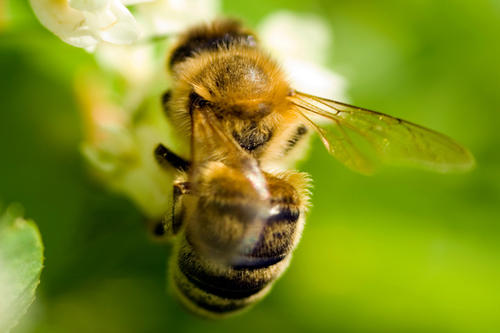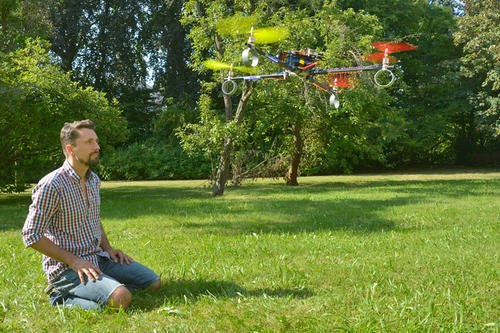GPS with an Insect Brain
Scientists Develop a Flying Robot That Can Orient Itself Autonomously
Sep 02, 2014
Bees as role model: Bees quickly learn how to orient themselves in unknown terrain.
Image Credit: ytk/photocase.com
Bioinformatics researcher Tim Landgraf and his team are working on simulations of brain structures that are supposed to enable learning processes in the flying robot’s control center.
Image Credit: Bernd Wannenmacher
It buzzes, and it flies – at first glance, that’s all the “NeuroCopter” has in common with a bee. And yet, the busy insect was the role model for the most important part in this approximately 90-centimeter flying robot: the control center. Researchers from Freie Universität are working on developing a “brain” for the robot that is as complex as that of a bee – so the robot can learn for itself how to get around. The results of this fundamental research could help with things like enhancing the performance of navigation systems, such as GPS.
Why bees specifically? “First, they have a small brain, an insect brain, which is easier to map than that of more complex life forms,” says Tim Landgraf, a researcher with the Intelligent Systems and Robotics Group at Freie Universität Berlin and head of the Biorobotics Lab there. “Second, bees are different from other insects in that they learn complex content astonishingly quickly. If you release them in an unknown area where they recognize a prominent feature like a tree that they have already had in their field of view from a different perspective on a previous flight, they can get their bearings right away and get back to the hive.”
This behavior, Landgraf says, is an indication that the animals “update” their mental images of their surroundings in their memory, which enables them to find their way in larger and larger areas. This ability to learn requires the animals to have a mental map. “We have found indications that this is the case, and we are studying those in another project,” Landgraf explains. “Forager bees use a dance to communicate information about locations to their fellow bees in the hive. Bees that have followed another bee’s dance fly right to the location they have learned in the dance – although it was totally unknown to them before. They even fly back and forth between known places and those they have learned from the dance. This is a strong indication that bees must have this kind of mental map.”
Researchers from the Biorobotics Lab, at the Institute of Computer Science, and Professor Martin Nawrot’s Neuroinformatics Group, at the Institute of Biology at Freie Universität, hope to leverage this complex navigation ability for robotics. So far, for example, it has been necessary to program information on the terrain into vehicles that can steer autonomously in order for them to find their way; the ability to get their bearings is thus entered from outside. The big goal for these researchers from Freie Universität now is for the NeuroCopter to capture information on routes by flying them and – like the neural processes that take place in a bee’s brain – compile them into its own internal map, which it successively expands, independently grasping destinations and flying there.
“We are still in the early stages,” Landgraf says. “We don’t know exactly which brain structures in bees perform this task. That’s why the NeuroCopter currently flies conventionally, with landmarks that have been programmed in. Some models and preliminary work for neuronal navigation in flight have already been successful, however.”
For example, the scientists have developed a crawler robot with a control center, likewise modeled on a bee’s brain, that senses its surroundings while moving, stores landmarks, and can approach these landmarks depending on the task – just as bees do with nectar-filled blossoms. The rover can even learn by association: It is rewarded with a light signal when it performs a task correctly, just as a bee is rewarded with nectar.
The researchers are also working with simulations. To this end, they feed information from an artificial world into brain structure models in a computer and then analyze how the simulated part of the brain reacts. If the reaction fits the desired result, the researchers know the network structure is working as planned, Landgraf explains, saying “In the future, we plan to transfer this approach to the real world by looking at how a bee completes a task and then comparing that against the NeuroCopter’s behavior by assigning it the same task.”
In this method, the researchers will be putting the flying robot in the same situation as a bee that has been released in an unknown location and has to reorient itself. They want to observe whether and how the NeuroCopter can use landmarks to find its way back home – to its own “hive” – and then compare this with data collected on bees.
First, however, the time needed to calculate these processes must be drastically shortened. The researchers’ tools include “spiking neural networks” (SNNs), complex and detailed simulations that are currently the best way to approximate natural neural networks.
Stimulation of each simulated nerve cell is described by a large number of equations, which are evaluated at very short intervals – several thousand times a second. The calculations for one second of real time can take as much as several hours, depending on the size of the network. “That’s why we are still using conventional models, and we plan to work our way toward neuronal processing step by step until the computation and storage processes run in parallel – and thus faster – like in real brains,” Landgraf says. “The neuroinformatics specialist Martin Nawrot is working with us to develop software for neuronal structures that are supposed to be overwritten into the robot’s hardware in the future.”
In the years to come, the researchers plan to compile a library of neuronal structures and combine them into a miniature brain. Plans call for the brain to live and learn in an artificial 3D world at first. This means it will be responsible for linking neurons independently – like a bee, which reacts to a prominent feature of the terrain when placed in unknown territory, thereby adding to its internal cognitive map.
If the learning process works, the miniature brain will be transferred into the NeuroCopter’s control center and tested in the real world. “Ideally, the brain will make the leap from simulation to the real world without a steep learning curve. Then it will be able to chart changing surroundings on its own,” Landgraf explains. “In this way, the brain of bees could be fundamental to the navigation technology of the future, revolutionizing present-day global positioning systems.”
Further Information
- Dr. Tim Landgraf, Institute of Computer Science, Freie Universität, Tel.: +49 30 838 75 118, Email: tim.landgraf [[AT]] fu-berlin.de
- Biorobotics Lab


